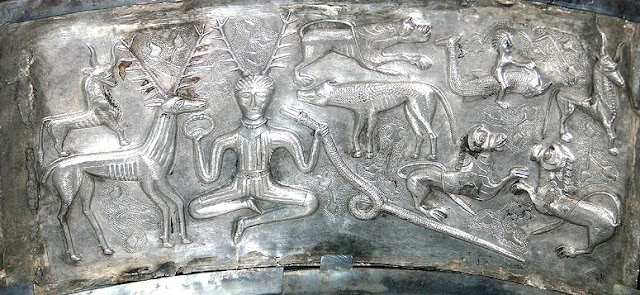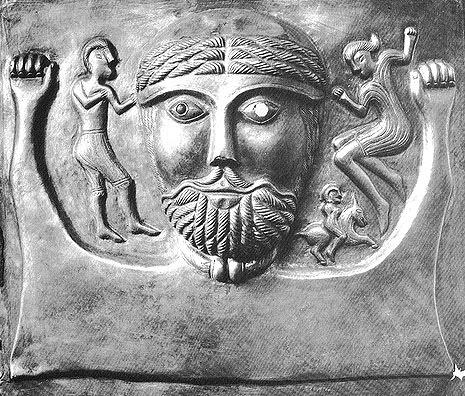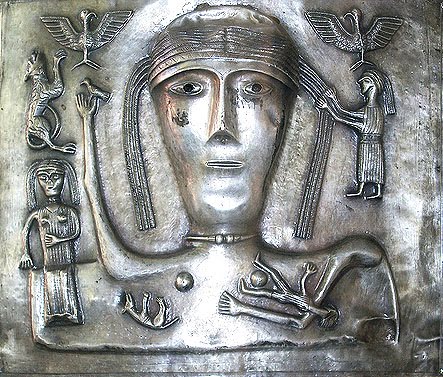 The plates are made of silver, depicting various motifs of human figures, animals and plants. Each of the seven external plates follow symetrical pattern, showing human busts: four males with upraised arms and three females.
The plates are made of silver, depicting various motifs of human figures, animals and plants. Each of the seven external plates follow symetrical pattern, showing human busts: four males with upraised arms and three females.
For an article about the history of Gundestrup Cauldron follow this link.
Internal plates are more complicated, filled with number of motifs, giving an impression of important mythological scenes. Some researchers believe the plates are meant to be some obscure calendar system or imaginery vision of the night sky.
The animals seem to have the look that would have come out of Anatolia. The elephant-like and lion-like figures have an Oriental touch.
A cauldron itself has an important place in early European world-view, associated with magical powers, transformation and ritual. Holy Graal legend is often thought to be a direct parrallel of the sacred use and meaning of ceremonial chalices, cauldrons and other vessels. The most known is the cauldron of Dagda in Irish mythology.
The Base
It is an impressive art-work in 3D, high-relief. An enormous bull lying down on the ground with the head up, solar-disc on its forehead and with overly long front legs. The horns are missing. What is striking and unusual - the bull is depicted as would be seen from above.
The background is filled with patterns of ivy. The plant is consequently present on some of the other plates.
Plate A
The most famous image, the central figure has been named Cernnunos after a documented horned deity in the Celtic lands of western Europe, mainly France. He is associated with fertility, material wealth, hunting, forest, and the Underworld. Usually depicted as an old man with beard, antler horns and torques hanging on them. Here, the figure is rather young and sexually ambiguous. Identification of the central figure with Cernunnos has been challenged by many scholars.
The legs of the horned figure are folded, he wears a torque around his neck, hold another torque in his right hand and a snake in his left. His tight-fitting costume covered with vertical strips is present on almost all other human figures on the cauldron (quite funny, actually; similar to popular male bathing suits from early 20th century, with one difference - the strips were horizontal, making an old chap look fat). Such costumes seem to confirm the more eastern origin of the Gundestrup Cauldron for no such examples have been found in Central and Western Europe.
The horned figure is surrounded by animals, some of them difficult to identify. On a far right and far left - bull-like creatures, others are - stag, hound, above the hound could be a lion, and a pair of lions on bottom left and a human riding a fish (some say dolphin some say sturgeon). In between the creatures are threefold ivy branches.
Plate B
A female figure wearing torque surrounded by three leaves on both sides and by connected wheels (could she be in a cart?). The wheels look very much like the Flower of Life, one of the most important and intriguing shapes in sacred geometry; its images are found in ancient sites and buildings around the world.
Two elephant-like creatures and two griffins on left and right and below the female figurea a large hound are found.
Plate C
It shows the bust of a bearded male holding on to an unfinished wheel. A smaller kneeling figure with a horned helmet is holding the rim of the wheel. Below those beautifuly shaped legs (I bet this is a young lady, with such legs!) is a ram-horned serpent. Three galloping griffins and two happy hounds, walking in opposite direction, sepparated by the ivy motifs, finish the scene.
Plate D
Generally interpreted as bull sacrifice (some see those three animals as horses but the tails aren't horse-ish). Three warriors wielding swords. Between the bulls' legs are sets of three leaves, and nexts to their heads - fours set of three leaves. It looks like the bulls are chained together by those leaves. Under the hooves of bulls are running dogs, and over the back of each bull is a running cat.
Plate E
Starting from bottom right: three carnyx players marching behind a procession of foot warriors facing a climbing dog. On the left side, a large figure is intending to bung a man in a oblong vessel. In the upper half, warriors on horses with animal headed helmets following a snake. In the centre of this scene is a plant pattern by many interpreted as axis mundi or sacred tree, lying horizontally. It is considered as an initiation scene.
***
The exterior plates, labeled - a, b, c, d, e, f, g - four male busts and three female busts with mysterious company of human and animal figures, as mentioned above. Clear and distinctive features to look at. Having met the interior plates already, it would be easier and more enjoyable to catch sight of all those details by oneself.
Plate a
Plate c
Plate d
Plate e
Plate f
Plate g














